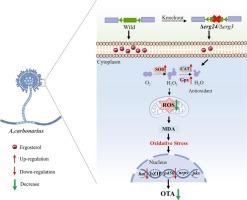麦角甾醇合成酶通过氧化应激途径减少碳曲霉赭曲霉毒素A的合成
IF 5.2
1区 农林科学
Q1 FOOD SCIENCE & TECHNOLOGY
International journal of food microbiology
Pub Date : 2025-08-22
DOI:10.1016/j.ijfoodmicro.2025.111395
引用次数: 0
摘要
赭曲霉毒素A (OTA),一种由曲霉和青霉产生的致癌真菌毒素,污染粮食作物并威胁公众健康。虽然麦角甾醇及其合成酶是重要的抗真菌靶点,但它们在OTA生产中的调节作用和机制尚不清楚。因此,阐明麦角甾醇合成酶基因erg3 (C-5甾醇去饱和酶)和erg24 (C-14甾醇还原酶)在碳曲霉氧化应激反应和OTA生物合成中的作用至关重要。本研究采用同源重组法敲除麦角甾醇合成酶基因erg3和erg24并过表达。在赤豆中鉴定出两个同源erg3 (erg3 - 1和erg3 - 5)和一个同源erg24。Δerg24显著降低麦角甾醇水平,而Δerg3-1显著增加麦角甾醇水平。值得注意的是,只有敲除erg24的突变体,包括单(Δerg24)、双(Δerg3-5Δerg24)和三(Δerg3-1Δerg3-5Δerg24)菌株,其OTA产量、菌落直径、分生孢子形成和发芽率显著降低。此外,转录组学分析显示Δerg24显著下调OTA生物合成基因pks和hal的表达,而调节ROS水平的抗氧化防御机制相关基因上调。酶分析证实过氧化氢酶(CAT)、超氧化物歧化酶(SOD)和谷胱甘肽(GSH)升高,同时ROS水平降低。该研究为麦角甾醇合成酶在OTA合成中的调控作用提供了新的见解,并为开发创新的抗真菌策略提供了潜在的靶点。本文章由计算机程序翻译,如有差异,请以英文原文为准。

Ergosterol synthase reduces ochratoxin A synthesis in aspergillus carbonarius via oxidative stress pathway
Ochratoxin A (OTA), a carcinogenic mycotoxin produced by Aspergillus and Penicillium species that contaminates food crops and threatens public health. Although ergosterol and its synthetic enzymes are important antifungal targets, their regulatory roles and mechanisms in OTA production remain unclear. Therefore, elucidating the roles of ergosterol synthase genes erg3 (C-5 sterol desaturase) and erg24 (C-14 sterol reductase) in oxidative stress response and OTA biosynthesis in Aspergillus carbonarius is of critical importance. Herein, we employed homologous recombination to knockout and overexpress ergosterol synthase gene erg3 and erg24 in A. carbonarius. We identified two homologous erg3 (erg3–1 and erg3–5) and one erg24 in A. carbonarius. Δerg24 significantly reduced ergosterol levels whereas Δerg3–1 markedly increased it. Notably, only mutant with erg24 knockout, including single (Δerg24), double (Δerg3–5Δerg24) and triple knockout (Δerg3–1Δerg3–5Δerg24) strains showed significantly reduced OTA production, colony diameter, conidial formation and germination rates. Furthermore, transcriptomic analysis revealed that Δerg24 significantly downregulated expression of OTA biosynthetic genes pks and hal, while genes associated with antioxidant defense mechanisms regulating ROS levels were upregulated. Enzyme assay confirmed that catalase (CAT), superoxide dismutase (SOD), and glutathione (GSH) were enhanced, accompanied by reduced ROS levels. This study provides new insights into the regulatory role of ergosterol synthase in OTA synthesis and potential targets for developing innovative antifungal strategies.
求助全文
通过发布文献求助,成功后即可免费获取论文全文。
去求助
来源期刊
CiteScore
10.40
自引率
5.60%
发文量
322
审稿时长
65 days
期刊介绍:
The International Journal of Food Microbiology publishes papers dealing with all aspects of food microbiology. Articles must present information that is novel, has high impact and interest, and is of high scientific quality. They should provide scientific or technological advancement in the specific field of interest of the journal and enhance its strong international reputation. Preliminary or confirmatory results as well as contributions not strictly related to food microbiology will not be considered for publication.

 求助内容:
求助内容: 应助结果提醒方式:
应助结果提醒方式:


